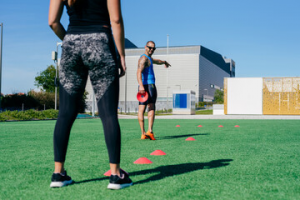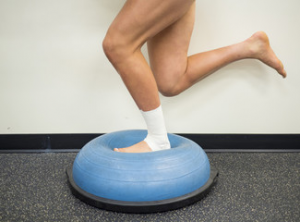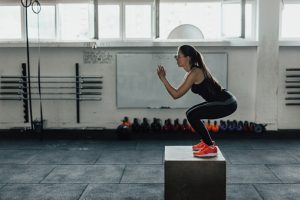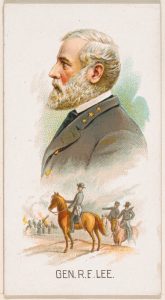There I was, rushing down the soccer field with the ball at my feet, adrenaline pumping through my veins, sweat rolling down my face. I reel my leg back to take a shot on goal just to hear a snap and to find myself lying on the field. Grabbing my knee, seeing my teammates surrounding me, it was at that moment I knew it had happened again. In a blink of an eye I saw nine months of surgery, recovery, and intense rehabilitation flash before me. I have torn my ACL for the third time within a four year span. With that being said, I am aiming to gather information regarding everything that goes into ACL prevention, including what steps are critical for that prevention, and how the prevention process can be strengthened in female athletes. “ACL tears range from two to four times greater in female basketball and soccer athletes than in males playing the same sports.”1 Female athletes are at greater risk to tear their ACL than males have ever been, and this article will embark on the precautions and preventative work that is seen to help the numbers of ACL tears in female athletes diminish.

Females have a higher tendency to tear their ACL, usually from accelerating, jumping, cutting, decelerating, landing, and doing short sprints, all of which are needed to perform at a higher levels in many sports. To stop the number of injuries, exercises have been created to strengthen all the athletic movements used when tearing the ACL ligament, in a prevention effort. Healing from my third tear, I have been doing a drill called the “T-drill,” which is a short cone drill that hones in on quick changing of directions and speeds, which is one of the number one causes of ACL tears in female athletes. The T-Drill is a well-known cone agility drill that is structured to strengthen the muscles needed to create those quick turns that female athletes are seen to do so often. This drill is the most widely used exercise for prevention of ACL tears when making these game-like movements.

Other aspects of prevention-work for females are eccentric and plyometric exercises. “It is apparent that, despite all of the training methods inducing improvement outcomes to various extents, combined (eccentric/plyometric) training was the most effective protocol to stimulate positive changes…On this basis, combined protocol represents the most efficacious training program as it exerts positive effects on both stability and functional performance in the period of elite female athletes.”2 Eccentric exercises are slow and long movements focusing on one muscle group. The most common exercise is single leg balance. Being a soccer player, I would do a lot of single leg balances on an uneven surface to promote balance as well as muscle strengthening. Furthering into my preventative work, I would do a single leg balance and add a volley with a soccer ball to mimic game-like scenarios. Ultimately, I want to have my muscle groups and balance as acquainted as possible.

Plyometric exercises, which are very beneficial to the prevention of ACL tears for females, are classified as quick bursts of jumping, usually seen in performing squat jumps, box jumps, and a number of landing drills. These are very important because the focus is on strengthening the fast twitch muscles, but mainly the shift of females’ knees when landing. My doctor always told me not to land from a jump and let my knees shift to the center of my body. This can cause extreme knee weakness as well as a high probability of injury. This is why plyometric exercises are very efficient when working to prevent ACL injuries, because it hones in on knee stability and strength.
There is so much that goes into prevention, especially for female athletes. As I am pursuing a job in medical sales, I’ve been persuaded that certain appliances can help this process tremendously. For example, the use of the Alter-G treadmill is an appliance that is targeted to take off pressure on the body when running, and is proven extremely effective. One starts by being zipped into a large inflatable bag attached to the treadmill. Once zipped in, air is inflated into the bag, which results in a run with no weight from your hips down. This exercise tool is astounding, being able to run without the constant impact and weight on athletes knees is very beneficial to protecting and preventing ACL injuries. Imagine what this device can also do for aging knees as well! Using the advanced technology that is at our disposal now, there are still ways to exercise and rehabilitate to work towards bringing ACL injuries down in female athletics.
ACL injuries in female athletes can have harmful effects to ones overall well-being throughout life, and can impair the basic fundamentals needed. Unfortunately, these types of injuries can be difficult to repair and have long-term lingering effects later in life, such as the encouragement of arthritis. Using some simple exercises can assure athletes, and anyone with an ACL tear, effective long-term rehab of the knee. More importantly, these simple repetitive drills can be used consistently to strength the knees of healthy athletes; but not all coaches and trainers understand and encourage this. Athletes like myself learn the hard way after repeated tears and physical therapy. ACL prevention programs continue to make improvements each year. Continued awareness of the risk factors for female athletes, along with the new innovations in technology and exercises, gives hope of one day narrowing down the numbers of ACL tears, especially in women.
- M. L. Ireland, “Anterior Cruciate Ligament Injury in Female Athletes: Epidemiology,” Journal of Athletic Training 34, no. 2 (April 1999): 150–54. ↵
- Sofien Kasmi et al., “The Effects of Eccentric and Plyometric Training Programs and Their Combination on Stability and the Functional Performance in the Post-ACL-Surgical Rehabilitation Period of Elite Female Athletes,” Frontiers in Physiology 12 (2021): 954, https://doi.org/10.3389/fphys.2021.688385. ↵



23 comments
Andrick Ferrer
I cannot imagine the strength and mental fortitude it would take for someone to go through not only one, not two, but three ACL injuries. I tore mine a couple of years ago and can testify that the process is gruesome and extensive. I liked that you included the fact that such injuries do not only affect the person physically, but mentally and emotionally as well. Thank you for providing such a great take on an injury that is very common. Great job Makenzie.
Natalia Ramirez
Thank you for this article! It was very informative, and it is good information to know, especially for athletes. I know of a lot of soccer players that have torn their ACL, and I can only imagine how painful it is. Not only is it painful, but it is also very heartbreaking since the recovery process is long, and therefore requires time away from activity.
Maria Luevano
What a great article, you truly did an amazing job keeping me entertained throughout the entire article! I have known a few people that have suffered an ACL injury, and am shocked to learn that something as simple as over-exertion can lead to this injury. It is so important to know how to prevent serious injuries such as this one, so thank you for writing this article and informing me as well as others!
Erika Longoria
This article was extremely interesting and informative. I’ve always heard of people experiencing ACL injuries, but never fully understood the extent of this type of injury. The article helps readers have a better understanding about ACL injury and female athletes. Another great thing I liked about this article is how it includes exercises for rehabilitation or prevention for ACL injuries and pictures of them as well.
Andrea Ramirez
Very good article; concise, clear and understandable.
I liked that you started your article telling your story, I felt that I was reading a book. It seemed surprising that most women athletes are the one who have the highest risk of tearing the ACL than men. To tell the truth, I would have liked you to put the why of this, because I stayed with that doubt.
Even so, I also liked that you put examples of ACL’s rehabilitating or preventive exercises, as this can really help other athletes to prevent them.
Finally, that you put pictures of the drills and preventive exercises in your article, did it more striking and let me understand how they are and how they look.
Elizabeth Saxon
I love how you incorporated drills that prevent further ACL tears in your article. I myself have torn my ACL twice in a span of three years. Reading the information you provided brought a whole new perspective on my outlook on tears. I never realized how it could affect me later in life. Knowing that women are more likely to tear their ACL, I think that every women athlete should definitely take percussion and do the designed ACL prevention drills to reduce the percentage of ACL tears in women.
Andrea Moreno
This article was incredibly interesting. Not only did I not know how common ACL injuries are, but I also had no clue how much they affected women. Seeing the prevention practices for ACL injuries and how they are improving over the years is fascinating. ACL injuries are always something that I had heard about, but I never knew how badly they can affect someone’s life long term.
Aaron Fanning
This was an great article that covers ACL tear and how serious it is. I’ve never torn my ACL before and I’m grateful but as an person that’s done cross country and track its very serious and even career altering even for female athletes. Overall, your article is great and how it highlighted this specific issue and how it can be helped.
Martha Nava
Very interesting, I did not know that tearing the ACL was more common in women than men. I think you did good research in finding the statistics and different technology that helps this issue. I can’t even imagine how painful tearing your ACL must be, and if you’re a female athlete the thought of tearing it must be very present, I assume. Overall, I liked your article and how it highlighted this specific issue and how it can be helped.
Eliana Villarreal
I have always heard of ACL tears in athletes because it has happened to my cousins before and their recovery processes were neither quick nor easy. Seeing it happen to them, though, I thought there was a vast amount of knowledge and effective treatment out there, but I did not realize that it is quite the opposite. Even if there is machines, such as the Alter-G Treadmill, to help prevent such injuries to athletes, I feel like the availability of it is difficult to find and not accessible to all. It would be amazing to find more preventatives for ACL tears as the sports industry is on a rise in our society.